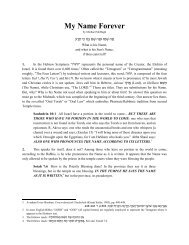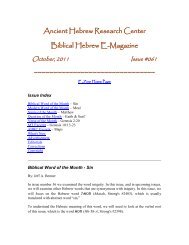Dating the Book of Job (PDF) - Ancient Hebrew Research Center
Dating the Book of Job (PDF) - Ancient Hebrew Research Center
Dating the Book of Job (PDF) - Ancient Hebrew Research Center
You also want an ePaper? Increase the reach of your titles
YUMPU automatically turns print PDFs into web optimized ePapers that Google loves.
<strong>Dating</strong> <strong>the</strong> <strong>Book</strong> <strong>of</strong> <strong>Job</strong> 17<br />
Because we are told that <strong>the</strong> flood began on <strong>the</strong> 17th day <strong>of</strong> <strong>the</strong> 2nd month and that 150 days<br />
later was <strong>the</strong> 17th day <strong>of</strong> <strong>the</strong> 7th month, we can derive that Noah was counting a month as being<br />
exactly 30 days in length (150 days divided by 5 months).<br />
The six-month-year interpretation <strong>of</strong> <strong>the</strong> flood story makes more sense than <strong>the</strong> twelve-monthyear<br />
interpretation because, in <strong>the</strong> six-month-year version, every day from when <strong>the</strong>y entered <strong>the</strong><br />
ark until when <strong>the</strong>y left is accounted for. With <strong>the</strong> twelve-month-year version, six months <strong>of</strong> time<br />
have to be inserted … somewhere …<br />
Also, <strong>the</strong> six-month-year interpretation <strong>of</strong> Noah’s flood recognizes <strong>the</strong> repetition in <strong>the</strong> story.<br />
Notice in particular <strong>the</strong> parallel between Genesis 8:3-6 and Genesis 8:13-14.<br />
– … At <strong>the</strong> end <strong>of</strong> one hundred and fifty days <strong>the</strong> waters diminished, so that in <strong>the</strong> seventh month, on <strong>the</strong> seventeenth<br />
day <strong>of</strong> <strong>the</strong> month, <strong>the</strong> ark came to rest on <strong>the</strong> mountains <strong>of</strong> Ararat. … At <strong>the</strong> end <strong>of</strong> forty days, Noah<br />
opened <strong>the</strong> window <strong>of</strong> <strong>the</strong> ark that he had made. (Genesis 8:3-6 NJPS)<br />
– And it came to pass in <strong>the</strong> six hundred and first year, in <strong>the</strong> first, <strong>the</strong> first <strong>of</strong> <strong>the</strong> month, that <strong>the</strong> waters were<br />
dried up from <strong>the</strong> earth; and Noah removed <strong>the</strong> covering <strong>of</strong> <strong>the</strong> ark and looked, and indeed <strong>the</strong> surface <strong>of</strong><br />
<strong>the</strong> ground was dry. And in <strong>the</strong> second month, on <strong>the</strong> twenty-seventh day <strong>of</strong> <strong>the</strong> month, <strong>the</strong> earth was dried.<br />
(Genesis 8:13-14 NKJV)<br />
Notice <strong>the</strong> bad grammar in <strong>the</strong> above excerpt from Genesis 8:13-14. They have been omitted<br />
from <strong>the</strong> above excerpt to illustrate <strong>the</strong> point, but <strong>the</strong> NKJV translation adds <strong>the</strong> words “month”<br />
and “day” to attempt to make sense <strong>of</strong> <strong>the</strong> peculiar wording (you will probably see <strong>the</strong>m italicized<br />
in your Bible). The <strong>Hebrew</strong> word for month – שׁדֹח ֶ (chodesh) – is used 9 times from Genesis 7:11<br />
to 8:14. Why should it be left out here? Likewise, <strong>the</strong> <strong>Hebrew</strong> word for day – םוֹי (yom) – is used<br />
15 times from Genesis 7:4 to 8:22. Why should <strong>the</strong> word be omitted here? The peculiar wording<br />
here in 8:13 and earlier in 8:5 is an indication <strong>of</strong> possible corruption <strong>of</strong> <strong>the</strong> original text (more to<br />
come about Genesis 8:5).<br />
There is also <strong>the</strong> problem <strong>of</strong> <strong>the</strong> earth being declared dry on two occasions that are well over a<br />
month apart in Genesis 8:13-14. The NJPS translation addresses this latter problem by translating<br />
<strong>the</strong> text “In <strong>the</strong> six hundred and first year, in <strong>the</strong> first month, on <strong>the</strong> first <strong>of</strong> <strong>the</strong> month, <strong>the</strong> waters<br />
began to dry from <strong>the</strong> earth; and when Noah removed <strong>the</strong> covering <strong>of</strong> <strong>the</strong> ark, he saw that <strong>the</strong> surface<br />
<strong>of</strong> <strong>the</strong> ground was drying. And in <strong>the</strong> second month, on <strong>the</strong> twenty-seventh day <strong>of</strong> <strong>the</strong> month, <strong>the</strong><br />
earth was dry”. The NJPS translation is obviously more sensible unless severe flooding <strong>of</strong> which<br />
we are not told occurred between <strong>the</strong> first and second drying <strong>of</strong> <strong>the</strong> earth. So, Genesis 8:13-14<br />
is telling us that at some point (<strong>the</strong> exact time <strong>of</strong> which is uncertain due to <strong>the</strong> corruption <strong>of</strong> <strong>the</strong><br />
text) <strong>the</strong> “waters began to dry from <strong>the</strong> earth” until <strong>the</strong> 27th day <strong>of</strong> <strong>the</strong> 2nd month <strong>of</strong> Noah’s 601st<br />
year when <strong>the</strong> earth was dry. Genesis 8:3-6 also tells us that on <strong>the</strong> 17th day <strong>of</strong> <strong>the</strong> 7th month <strong>the</strong><br />
waters began diminishing and 40 days later Noah opened <strong>the</strong> window <strong>of</strong> <strong>the</strong> ark to send out birds<br />
to test <strong>the</strong> land. Coincidently, when <strong>the</strong> 40 days <strong>of</strong> Genesis 8:6 are subtracted from <strong>the</strong> 601/2/27<br />
<strong>of</strong> Genesis 8:14 <strong>the</strong> result is 601/1/17 which just happens to be <strong>the</strong> 17th day <strong>of</strong> <strong>the</strong> 7th month on a<br />
six-month per year calendar! This means that Genesis 8:13-14 is a reiteration <strong>of</strong> <strong>the</strong> 40 days from<br />
when <strong>the</strong> ark landed on <strong>the</strong> mountain to when <strong>the</strong> earth was dry (dry enough to start sending out<br />
<strong>the</strong> birds that is). It is likely that <strong>the</strong> fist part <strong>of</strong> Genesis 8:13 originally read “And it came to pass<br />
in <strong>the</strong> six hundred and first year, in <strong>the</strong> first month, on <strong>the</strong> seventeenth day <strong>of</strong> <strong>the</strong> month …”.<br />
The removal <strong>of</strong> <strong>the</strong> covering <strong>of</strong> <strong>the</strong> ark, as stated in Genesis 8:13 was probably a one-time<br />
event. The “covering” was probably some massive sheet over <strong>the</strong> top <strong>of</strong> <strong>the</strong> ark to prevent any <strong>of</strong><br />
<strong>the</strong> immense quantity <strong>of</strong> rain water that poured down over <strong>the</strong> 150 days from getting into <strong>the</strong> ark. It






